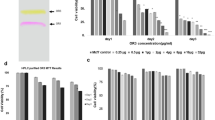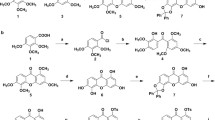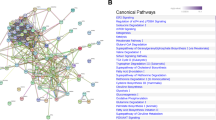Abstract
This study assessed OR3 pigment, derived from Streptomyces coelicolor JUACT03, for its anticancer potential on HepG2 liver cancer cells and its safety on HEK293 normal cells. OR3 induced apoptosis and inhibited HepG2 cell proliferation, confirmed by caspase activation, Sub-G1 phase cell cycle arrest, and reduced colony formation. Proteomic analysis revealed altered expression of proteins associated with ribosomal function, mRNA processing, nuclear transport, proteasome activity, carbohydrate metabolism, chaperone function, histone regulation, and vesicle-mediated transport. Downregulation of proteins in MAPKAP kinase1, EIF2, mTOR, and EIF4 pathways contributed to apoptosis and cell cycle arrest. Changes in c-MYC, FUBP1 target proteins and upregulation of Prohibitin-1 (PHB1) were also noted. Western blot analysis supported alterations in eIF2, mTOR, and RAN pathways, including downregulation of RAB 5, c-MYC, p38, MAPK1, and MAPK3. OR3 exhibited significant anti-angiogenic activity in the in ovo CAM assay. In summary, OR3 demonstrated strong anticancer effects, inducing apoptosis, hindering proliferation, and displaying antiangiogenic properties. These findings highlight OR3’s potential as an anticancer drug candidate, warranting further in vivo exploration.
Graphical Abstract










Similar content being viewed by others
Data Availability
All the data that support the findings of this current study are included in this article and the mass spectrometry-based proteomics data have been deposited in the ProteomeXchange Consortium via the PRIDE partner repository with the dataset identifier PXD043439.
References
Sung, H., Ferlay, J., Siegel, R. L., Laversanne, M., Soerjomataram, I., Jemal, A., & Bray, F. (2021). Global cancer statistics 2020: GLOBOCAN estimates of incidence and mortality worldwide for 36 cancers in 185 countries. A Cancer Journal for Clinicians, 71, 209–249. https://doi.org/10.3322/caac.21660.
Machana, S., Weerapreeyakul, N., & Barusrux, S. (2012). Anticancer effect of the extracts from Polyalthia evecta against human hepatoma cell line (HepG2). Asian Pacific Journal of Tropical Biomedicine, 2(5), 368–374. https://doi.org/10.1016/S2221-1691(12)60058-6.
Zheng, Y., Zhang, W., Xu, L., Zhou, H., Yuan, M., & Xu, H. (2022). Recent progress in understanding the action of natural compounds at novel therapeutic drug targets for the treatment of liver cancer. Frontiers in Oncology, 11, 795548. https://doi.org/10.3389/fonc.2021.795548.
Narsing Rao, M. P., Xiao, M., & Li, W. J. (2017). Fungal and bacterial pigments: Secondary metabolites with wide applications. Frontiers in Microbiology, 8, 1113. https://doi.org/10.3389/fmicb.2017.01113.
Montaner, B., & Pérez-Tomás, R. (2003). The prodigiosins: A new family of anticancer drugs. Current Cancer Drug Targets, 3(1), 57–65. https://doi.org/10.2174/1568009033333772.
Williamson, N. R., Fineran, P. C., Gristwood, T., Chawrai, S. R., Leeper, F. J., & Salmond, G. P. (2007). Anticancer and immunosuppressive properties of bacterial prodiginines. Future Microbiology, 2(6), 605–618. https://doi.org/10.2217/17460913.2.6.605.
Wang, Y., Nakajima, A., Hosokawa, K., Soliev, A. B., Osaka, I., Arakawa, R., & Enomoto, K. (2012). Cytotoxic prodigiosin family pigments from Pseudoalteromonas sp. 1020R isolated from the Pacific coast of Japan. Bioscience Biotechnology and Biochemistry, 76(6), 1229–1232. https://doi.org/10.1271/bbb.110984.
Feng, Y., Shao, Y., & Chen, F. (2012). Monascus pigments. Applied Microbiology and Biotechnology, 96, 1421–1440. https://doi.org/10.1007/s00253-012-4504-3.
El-Naggar, N. A., & El-Ewasy, S. (2017). Bioproduction, characterization, anticancer and antioxidant activities of extracellular melanin pigment produced by newly isolated microbial cell factories Streptomyces glaucescens NEAE-H. Scientific Reports, 7, 42129. https://doi.org/10.1038/srep42129.
Olano, C., Mendez, C., & Salas, J. A. (2009). Antitumor compounds from marine actinomycetes. Marine Drugs, 7(2), 210–248. https://doi.org/10.3390/md7020210.
D, S., Dammalli, M., & Nadumane, V. K. (2023). Proteomic analysis of human breast cancer MCF-7 cells to identify cellular targets of the anticancer pigment OR3 from Streptomyces coelicolor JUACT03. Applied Biochemistry and Biotechnology, 195, 236–252. https://doi.org/10.1007/s12010-022-04128-8.
Mosmann, T. (1983). Rapid colourimetric assay for cellular growth and survival: Application to proliferation and cytotoxicity assays. Journal of Immunological Methods, 65(1–2), 55–63. https://doi.org/10.1016/0022-1759(83)90303-4.
Pozarowski, P., & Darzynkiewicz, Z. (2004). Analysis of cell cycle by fow cytometry. Methods in Molecular Biology, 281, 301–311. https://doi.org/10.1385/1-59259-811-0301.
Franken, N., Rodermond, H., & Stap, J., et al. (2006). Clonogenic assay of cells in vitro. Nature Protocols, 1, 2315–2319. https://doi.org/10.1038/nprot.2006.339.
Huang, P., Ballal, K., & Plunkett, W. (1997). Biochemical characterization of the protein activity responsible for high molecular weight DNA fragmentation during drug-induced apoptosis. Cancer Research, 57(16), 3407–3414.
Aneesh Kumar, A., Ajith Kumar, G. S., Satheesh, G., Surendran, A., Chandran, M., Kartha, C. C., & Jaleel, A. (2021). Proteomics analysis reveals diverse molecular characteristics between endocardial and aortic-valvular endothelium. Genes, 12(7), 1005. https://doi.org/10.3390/genes12071005.
Kumar, C., & Mann, M. (2009). Bioinformatics analysis of mass spectrometry-based proteomics data sets. Federation of European Biochemical Societies, 583(11), 1703–1712. https://doi.org/10.1016/j.febslet.2009.03.035.
Ponce, M. L., & Kleinmann, H. K. (2003). The chick chorioallantoic membrane as an in vivo angiogenesis model. Current Protocols in Cell Biology, 19. https://doi.org/10.1002/0471143030.cb1905s18.
Ramer, R., Schmied, T., Wagner, C., Haustein, M., & Hinz, B. (2018). The antiangiogenic action of cisplatin on endothelial cells is mediated through the release of tissue inhibitor of matrix metalloproteinases-1 from lung cancer cells. Oncotarget, 9(75), 34038–34055. https://doi.org/10.18632/oncotarget.25954.
Ribatti, D., Vacca, A., Roncali, L., & Dammacco, F. (1996). The chick embryo chorioallantoic membrane as a model for in vivo research on angiogenesis. The International Journal of Developmental Biology, 40(6), 1189–1197.
Zudaire, E., Gambardella, L., Kurcz, C., & Vermeren, S. (2011). A computational tool for quantitative analysis of vascular networks. Public Library of Science, 6(11), e27385. https://doi.org/10.1371/journal.pone.0027385.
Perin, J., Mulick, A., Yeung, D., Villavicencio, F., Lopez, G., Strong, K. L., Prieto-Merino, D., Cousens, S., Black, R. E., & Liu, L. (2022). Global, regional, and national causes of under-5 mortality in 2000-19: An updated systematic analysis with implications for the Sustainable Development Goals. The Lancet Child & Adolescent Health, 6(2), 106–115. https://doi.org/10.1016/S2352-4642(21)00311-4.
Sharma, V., Kaur, R., & Salwan, R. (2021). Streptomyces: Host for refactoring of diverse bioactive secondary metabolites. 3 Biotech, 11(7), 340. https://doi.org/10.1007/s13205-021-02872-y.
Osama, N., Bakeer, W., Raslan, M., Soliman, H. A., Abdelmohsen, U. R., & Sebak, M. (2022). Anti-cancer and antimicrobial potential of five soil Streptomycetes: A metabolomics-based study. Royal Society Open Science, 9(2), 211509. https://doi.org/10.1098/rsos.211509.
Kof, J., Ramachandiran, S., & Bernal-Mizrachi, L. (2015). A time to kill: Targeting apoptosis in cancer. The International Journal of Molecular Sciences, 16, 2942–2955. https://doi.org/10.3390/ijms16022942.
Sun, S., Hail, N., & Lotan, R. (2004). Apoptosis as a novel target for cancer chemoprevention. Journal of the National Cancer Institute, 96, 662–672. https://doi.org/10.1093/jnci/djh123.
Shipley, P. R., Donnelly, C. C., Le, C. H., Bernauer, A. D., & Klegeris, A. (2009). Antitumor activity of asukamycin, a secondary metabolite from the actinomycete bacterium Streptomyces nodosus subspecies asukaensis. International Journal of Molecular Medicine, 24(5), 711–715. https://doi.org/10.3892/ijmm_00000283.
Kar, S. (2016). Unraveling cell-cycle dynamics in cancer. Cell Systems, 2(1), 8–10. https://doi.org/10.1016/j.cels.2016.01.007.
Ma, A., Jiang, K., & Chen, B., et al. (2021). Evaluation of the anticarcinogenic potential of the endophyte, Streptomyces sp. LRE541 isolated from Lilium davidii var. unicolor (Hoog) Cotton. Microbial Cell Factory, 20, 217. https://doi.org/10.1186/s12934-021-01706-z.
Santamaria, D., Barriere, C., & Cerqueira, A., et al. (2007). Cdk1 is sufficient to drive the mammalian cell cycle. Nature, 448, 811–815. https://doi.org/10.1038/nature06046.
Namazi, S. N., Sepehri, H., Delphi, L., Moridi, F. M., & Eupatorin, S. (2018). Potentiate doxorubicin-induced apoptosis and cell cycle arrest in HT-29 and SW948 human colon cancer cells. Asian Pacific Journal of Cancer Prevention, 19(1), 131–139. https://doi.org/10.22034/APJCP.2018.19.1.131.
Begolli, R., Chatziangelou, M., & Samiotaki, M., et al. (2023). Transcriptome and proteome analysis reveals the anti-cancer properties of Hypnea musciformis marine macroalga extract in liver and intestinal cancer cells. Human Genomics, 17, 71. https://doi.org/10.1186/s40246-023-00517-0.
Wang, W., Jia, W. D., Hu, B., & Pan, Y. Y. (2017). RAB10 overexpression promotes tumor growth and indicates poor prognosis of hepatocellular carcinoma. Oncotarget, 8(16), 26434–26447. https://doi.org/10.18632/oncotarget.15507.
Jian, Z., Zhang, L., Jin, L., Lan, W., Zhang, W., & Gao, G. (2020). Rab5 regulates the proliferation, migration and invasion of glioma cells via cyclin. Oncology Letters, 20(2), 1055–1062. https://doi.org/10.3892/ol.2020.11660.
Zheng, W., Zheng, Y., Bai, X., Zhou, Y., Yu, L., Ji, D., Leng, K., Meng, N., Wang, H., Huang, Z., Xu, Y., & Cui, Y. (2022). RPNs levels are prognostic and diagnostic markers for hepatocellular carcinoma. Journal of Oncology, 2022, 7270541. https://doi.org/10.1155/2022/7270541.
Wang, L., Zhou, W., Li, H., Yang, H., & Shan, N. (2020). Clinical significance, cellular function, and potential molecular pathways of CCT7 in endometrial cancer. Frontiers in Oncology, 10, 1468. https://doi.org/10.3389/fonc.2020.01468.
Zmorzynski, S., Popek-Marciniec, S., Styk, W., Wojcierowska-Litwin, M., Korszen-Pilecka, I., Szudy-Szczyrek, A., Chocholska, S., Hus, M., & Filip, A. A. (2020). The impact of the NOD2/CARD15 variant (3020insC) and PSMA6 polymorphism (-8C>G) on the development and outcome of multiple myeloma. BioMed Research International, 2020, 7629456. https://doi.org/10.1155/2020/7629456.
Murphy, M. E. (2013). The HSP70 family and cancer. Carcinogenesis, 34(6), 1181–1188. https://doi.org/10.1093/carcin/bgt111.
Wang, Y., & Wang, X. (2022). A pan-cancer analysis of heat-shock protein 90 Beta1(HSP90B1) in human tumours. Biomolecules, 12(10), 1377. https://doi.org/10.3390/biom12101377.
Li, W., & Liu, J. (2022). The prognostic and immunotherapeutic significance of AHSA1 in pan-cancer, and its relationship with the proliferation and metastasis of hepatocellular carcinoma. Frontiers in Immunology, 13, 845585. https://doi.org/10.3389/fimmu.2022.845585.
Liu, W., Lu, Y., Yan, X., Lu, Q., Sun, Y., Wan, X., Li, Y., Zhao, J., Li, Y., & Jiang, G. (2022). Current understanding on the role of CCT3 in cancer research. Frontiers in Oncology, 12, 961733. https://doi.org/10.3389/fonc.2022.961733.
Elhamamsy, A. R., Metge, B. J., Alsheikh, H. A., Shevde, L. A., & Samant, R. S. (2022). Ribosome biogenesis: A central player in cancer metastasis and therapeutic resistance. Cancer Research, 82(13), 2344–2353. https://doi.org/10.1158/0008-5472.CAN-21-4087.
Shi, R., & Liu, Z. (2022). RPL15 promotes hepatocellular carcinoma progression via regulation of RPs-MDM2-p53 signaling pathway. Cancer Cell International, 22, 150. https://doi.org/10.1186/s12935-022-02555-5.
Geuens, T., Bouhy, D., & Timmerman, V. (2016). The hnRNP family: Insights into their role in health and disease. Human Genetics, 135, 851–867. https://doi.org/10.1007/s00439-016-1683-5.
Zhao, B., Lv, X., Zhao, X., Maimaitiaili, S., Zhang, Y., Su, K., Yu, H., Liu, C., & Qiao, T. (2022). Tumor-promoting actions of HNRNP A1 in HCC are associated with cell cycle, mitochondrial dynamics, and necroptosis. The International Journal of Molecular Sciences, 23(18), 10209. https://doi.org/10.3390/ijms231810209.
Shang, R. Z., Qu, S. B., & Wang, D. S. (2016). Reprogramming of glucose metabolism in hepatocellular carcinoma: Progress and prospects. World Journal of Gastroenterology, 22(45), 9933–9943. https://doi.org/10.3748/wjg.v22.i45.9933.
Barbier-Torres, L., & Lu, S. C. (2020). Prohibitin 1 in liver injury and cancer. Experimental Biology and Medicine (Maywood), 245(5), 385–394. https://doi.org/10.1177/1535370220908257.
Zhang, T., Wang, Y., Yu, H., Zhang, T., Guo, L., Xu, J., Wei, X., Wang, N., Wu, Y., Wang, X., & Huang, L. (2022). PGK1 represses autophagy-mediated cell death to promote the proliferation of liver cancer cells by phosphorylating PRAS40. Cell Death and Disease, 13(1), 68. https://doi.org/10.1038/s41419-022-04499-0.
Huang, J., & Manning, B. D. (2008). The TSC1-TSC2 complex: A molecular switchboard controlling cell growth. Biochemical Journal, 412(2), 179–190. https://doi.org/10.1042/BJ20080281.
Roux, P. P., Ballif, B. A., Anjum, R., Gygi, S. P., & Blenis, J. (2004). Tumor-promoting phorbol esters and activated Ras inactivate the tuberous sclerosis tumor suppressor complex via p90 ribosomal S6 kinase. The Proceedings of the National Academy of Sciences, 101(37), 13489–13494. https://doi.org/10.1073/pnas.0405659101.
Zhong, X., Persaud, L., Muharam, H., Francis, A., Das, D., Aktas, B. H., & Sauane, M. (2018). Eukaryotic translation initiation factor 4A down-regulation mediates interleukin-24-induced apoptosis through inhibition of translation. Cancers (Basel), 10, 153. https://doi.org/10.3390/cancers10050153.
Zhang, L., Zhang, Y., Zhang, S., Qiu, L., Zhang, Y., Zhou, Y., Han, J., & Xie, J. (2022). Translational Regulation by eIFs and RNA Modifications in Cancer. Genes (Basel), 13(11), 2050. https://doi.org/10.3390/genes13112050.
Yue, Q., Meng, L., Jia, B., & Han, W. (2020). Expression of eukaryotic translation initiation factor 3 subunit B in liver cancer and its prognostic significance. Experimental and Therapeutic Medicine, 20(1), 436–446. https://doi.org/10.3892/etm.2020.8726.
Yang, L., Zhu, J. Y., Zhang, J. G., Bao, B. J., Guan, C. Q., Yang, X. J., Liu, Y. H., Huang, Y. J., Ni, R. Z., & Ji, L. L. (2016). Far upstream element-binding protein 1 (FUBP1) is a potential c-Myc regulator in esophageal squamous cell carcinoma (ESCC) and its expression promotes ESCC progression. Tumour Biology, 37(3), 4115–4126. https://doi.org/10.1007/s13277-015-4263-8.
Xianpeng, L. I., Huaixi, Y. U., Feng, X. U., Yifeng, W. U., & Jifang, S. (2021). Differentially expressed long noncoding RNAs involved in FUBP1 promoting hepatocellular carcinoma cells proliferation. BioMed Research International, 2021, 6664519. https://doi.org/10.1155/2021/6664519.
Yang, L., Hu, B., & Zhang, Y., et al. (2015). Suppression of the nuclear transporter-KPNβ1 expression inhibits tumor proliferation in hepatocellular carcinoma. Medical Oncology, 32, 128. https://doi.org/10.1007/s12032-015-0559-1.
Wellmann, A., Flemming, P., Behrens, P., Wuppermann, K., Lang, H., Oldhafer, K., Pastan, I., & Brinkmann, U. (2001). High expression of the proliferation and apoptosis associated CSE1L/CAS gene in hepatitis and liver neoplasms: Correlation with tumor progression. International Journal of Molecular Medicine, 7, 489–494. https://doi.org/10.3892/ijmm.7.5.489.
Zhang, X., Zhang, X., Mao, T., Xu, H., Cui, J., Lin, H., & Wang, L. (2021). CSE1L, as a novel prognostic marker, promotes pancreatic cancer proliferation by regulating the AKT/mTOR signaling pathway. Journal of Cancer, 12(10), 2797–2806. https://doi.org/10.7150/jca.54482.
Youn, M., Gomez, J. O., Mark, K., & Sakamoto, K. M. (2021). RSK isoforms in acute myeloid leukemia. Biomedicines, 9(7), 726. https://doi.org/10.3390/biomedicines9070726.
Zhu, J., Blenis, J., & Yuan, J. (2008). Activation of PI3K/Akt and MAPK pathways regulates Myc-mediated transcription by phosphorylating and promoting the degradation of Mad1. The Proceedings of the National Academy of Sciences, 105, 6584–6589. https://doi.org/10.1073/pnas.0802785105.
Folkman, J. (1971). Tumor angiogenesis: Therapeutic implications. The New England Journal of Medicine, 285(21), 1182–1186. https://doi.org/10.1056/NEJM197111182852108.
Khalid, E. B., Ayman, E. E., Rahman, H., Abdelkarim, G., & Najda, A. (2016). Natural products against cancer angiogenesis. Tumor Biology, 37(11), 14513–14536. https://doi.org/10.1007/s13277-016-5364-8.
Ahmed, S. A., Mendonca, P., Elhag, R., & Soliman, K. F. A. (2022). Anticancer effects of fucoxanthin through cell cycle arrest, apoptosis induction, angiogenesis inhibition, and autophagy modulation. The International Journal of Molecular Sciences, 23(24), 16091. https://doi.org/10.3390/ijms232416091.
Tuncer, S., & Banerjee, S. (2015). Eicosanoid pathway in colorectal cancer: Recent updates. World Journal of Gastroenterology, 21(41), 11748–11766. https://doi.org/10.3748/wjg.v21.i41.11748.
Acknowledgements
The JRF fellowship granted to the research scholar, S.D., by Council of Scientific and Industrial Research (CSIR), India is greatly acknowledged. The authors would like to acknowledge the infrastructural facilities provided by JAIN (Deemed to be University), Bengaluru, for carrying out the research work.
Author information
Authors and Affiliations
Contributions
Conceptualization: V.K.N.; Methodology: V.K.N. and S.D.; Formal analysis and investigation: S.D.; Supervision: V.K.N.; Writing—original draft preparation: S.D.; Writing—review and editing: V.K.N.; all authors reviewed and approved the manuscript.
Corresponding author
Ethics declarations
Conflict of Interest
The authors declare no competing interests.
Additional information
Publisher’s note Springer Nature remains neutral with regard to jurisdictional claims in published maps and institutional affiliations.
Rights and permissions
Springer Nature or its licensor (e.g. a society or other partner) holds exclusive rights to this article under a publishing agreement with the author(s) or other rightsholder(s); author self-archiving of the accepted manuscript version of this article is solely governed by the terms of such publishing agreement and applicable law.
About this article
Cite this article
Derangula, S., Nadumane, V.K. Analysis of the Anticancer Mechanism of OR3 Pigment from Streptomyces coelicolor JUACT03 Against the Human Hepatoma Cell Line Using a Proteomic Approach. Cell Biochem Biophys (2024). https://doi.org/10.1007/s12013-024-01258-0
Accepted:
Published:
DOI: https://doi.org/10.1007/s12013-024-01258-0




